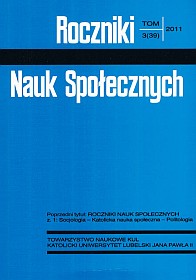Problematyka demograficzna tzw. ściany wschodniej Rzeczypospolitej Polskiej
Abstrakt
The article presents demographic changes occurring in the borderland area situated in the immediate neighborhood of the Polish-Lithuanian, Polish-Byelorussian and Polish-Ukrainian borders. In the Polish specialist literature the area is called “the Eastern Wall”. The author draws the reader’s attention to the lack of precision of this term and to the freedom with which it is used, as well as to the fact that with time it has been assuming a negative meaning.
In order to check the research hypothesis saying that there are de-population areas near the eastern border of Poland an empirical analysis has been made. On the basis of statistical documents demographic changes have been presented and commented on, according to the three levels of local government administration (województwo, powiat, gmina). The most interesting facts have been revealed by an analysis of the lowest level units (gmina). Information has been compared about their population, according to five time points (1970, 1978, 1988, 1996, 2008). This has made it possible to define the demographic dynamics. The results are unambiguous, and they show that nearly all the studied gminas are characterized by demographic regress. The rate of decrease in their population has been accelerating with time. Depopulation processes are result of a negative migration balance and of the natural drop. The decreasing number of births is connected with an increase in death rate. The opinion about the existence of the so-called “Eastern Wall”, in which negative demographic-social processes are cumulated has been confirmed by facts. Empirical analysis based on the data from three first level units (województwo), 16 second level units (powiat) and 51 third level units (gmina) has showed that the discussed eastern part of the borderland is not homogeneous and it is spatially differentiated. It has been revealed that each of the borderland segments has its own, clearly distinguished, demographic specificity. The most unfavorable demographic situation, which is connected with the increasing depopulation processes, obtains in the central part of the Polish eastern border. The area is situated along the Polish-Byelorussian border, and partly at the northern part of the Polish-Ukrainian border. At this borderland segment, more than 600 km long, we see several negative phenomena and demographic processes overlapping, which in the future may lead to a complete depopulation of the borderland areas. This will give significant economic consequences.
In the conclusion attempts are made to show that studies of the borderland areas not only have a great cognitive significance, but a planning significance as well, since they may be a premise for creating programs activating the area.
Bibliografia
Gorzym-Wilkowski W., Miszczuk A.: Wpływ granicy na przemiany sieci miast pogranicza polsko-białorusko-ukraińskiego, „Annales Universitatis M. Curie-Skłodowska” 1998, sect. K., vol. 5, s. 201-212.
Gospodarka – Przestrzeń – Środowisko. Strategia rozwoju województw wschodniego i zachodniego pogranicza Polski w kontekście integracji z Unią Europejską, red. A. Stasiak, R. Horodeński, C. Sadowska-Snarska, Białystok: Wydawnictwo Wyższej Szkoły Ekonomicznej 2001.
Granica wschodnia: szanse i bariery, Lublin: Ogólnopolskie Forum 1996.
Miszczuk A., Miszczuk M., Żuk K.: Gospodarka samorządu terytorialnego, Warszawa: Wydawnictwo Naukowe PWN 2007.
Miszczuk A.: Wpływ wyludniania się wsi na rolnictwo wschodniej Lubelszczyzny, Warszawa: IGiPZ PAN 1991.
Obszary wiejskie: przyszłość obszarów wiejskich Lubelszczyzny, red. C. Listowski, I. Pietrasińska, Lublin: Związek Gmin Lubelszczyzny 1999.
Podraza A.: Problem pograniczny w Europie Środkowo-Wschodniej (na przykładzie pogranicza polsko-ukraińskiego), w: Europa. Galicja. Regiony, red. A. Podraza, Kraków: Księgarnia Akademicka 2006, s. 129-154.
Pogranicze polsko-ukraińskie. Środowisko. Społeczeństwo. Gospodarka, red. B. Kawałko, A. Miszczuk, Zamość: Wyższa Szkoła Zarządzania i Administracji 2005.
Stasiak A.: Wybrane problemy zagospodarowania przestrzennego obszarów pogranicza zachodniego i wschodniego, „Nauka Polska” 1992, nr 1/2, s. 51-60.
Statystyczne studium rozwoju rolnictwa województwa lubelskiego, red. E. Nowak, Lublin: Wydawnictwo UMCS 1996.
Strategia rozwoju Euroregionu Bug, red. J. Polski, Lublin: Norbertinum 1997, Euroregion Bug, t. XVI.
Turowski W., Redmann M.: Euroregion Bug, Bydgoszcz: Sigma Media 2002.
Copyright (c) 2011 Roczniki Nauk Społecznych

Utwór dostępny jest na licencji Creative Commons Uznanie autorstwa – Użycie niekomercyjne – Bez utworów zależnych 4.0 Międzynarodowe.


